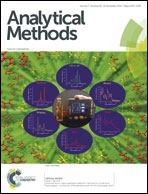A fluorophore-conjugated ascorbic acid functions for the visualization of sodium vitamin C transporters in living cells
Abstract
Human beings do not produce ascorbic acid (AA) and acquire AA through the sodium vitamin C transporters (SVCTs). Changes in the expression or function of SVCT proteins may be associated with human diseases. In this regard, imaging of SVCTs in living cells is important. However, the options for live-cell labelling of SVCTs were very limited. In this work, we synthesized a new small-molecule fluorescent probe RB–A–Vc, and demonstrated its application in selectively visualizing SVCTs in living cells. This probe features visible excitation and emission profiles, can easily enter into membranes, has high selectivity for SVCTs, and can monitor up-regulation or down-regulation of SVCT expression in living cells. We emphasize that this small-molecule probe is suitable for subcellular localization of SVCTs in living cells. This study provides a useful tool for simultaneously monitoring the level and distribution of intracellular SVCTs, which is probably more useful for evaluating the changes induced by external stimulations. We propose that this probe for SVCT imaging and the corresponding method could be applied to other cell lines, tissues, and species.


 Please wait while we load your content...
Please wait while we load your content...